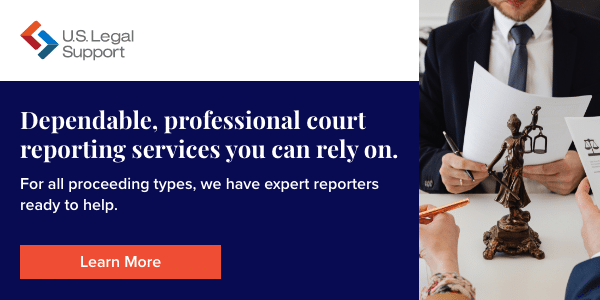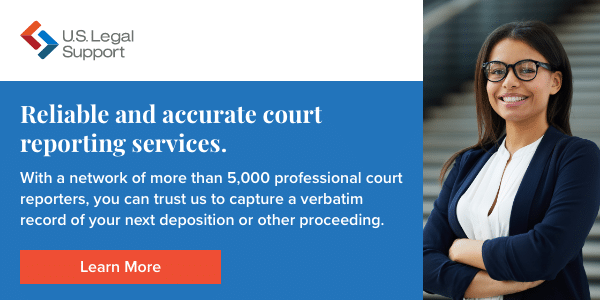Types of Court Reporters: An Overview

Court reporters—long known as “guardians of the record”—may be among the last professionals who are held accountable for true accuracy and impartiality of the written word. Their job is to capture each spoken word of a legal proceeding and generate a written transcript which becomes the official record of that event.
Contrary to the job title, court reporting isn’t limited to actual courtrooms. There are different types of court reporters in terms of career path, technology, and specialization.
The Basics of Court Reporting
Court reporters are key to the legal process and provide multiple functions. They’re trained to use technological tools alongside complex skills to:
- Capture every spoken word and identify the speaker
- Generate realtime written records that can be read back to the court or other audience
- Facilitate audio-to-text feeds that can generate captions, searchable text, or translations
- Submit official transcripts that act as legal records of trials and other proceedings or events
Court Reporter Skills and Training
Court reporters either use machine-based stenography to capture spoken words in a phonetic code (that is then translated by software to written text) or tools that translate audio input to text. They are ultimately responsible for producing and confirming accurate, impartial records, and their training and functions break down into two areas of responsibility:
- Using the technology – Utilizing correct process and methodology to complete the job
- Acting within legal guidelines – Operating as a recognized part of the legal system
To accomplish this, court reporters:
- Complete a dedicated court reporting associate’s degree or certificate program
- Become certified by a professional organization specific to their preferred methodology
- Obtain a license to practice in their state after completing an exam and skills testing
- Become a Notary Public in their state
In addition to legal proceedings, court reporters have the skills to act as simultaneous transcribers to create captions for deaf and hard of hearing (HOH) audiences during live events or broadcasts.
Court Reporter Salaries
The average annual salary for a mid-career court reporter in the U.S. is $76,080 (or about $37 per hour), but the range tops out in six figures with the top 10% earning an average of $114,000. Pay depends on:
- City (head for San Francisco, New York City, DC, Vegas, Boston, or Austin for top pay)
- State (New Jersey, California, New York, Alaska, Illinois, and Nevada pay the most)
- Experience and skill level
- Methodologies (Stenography and Voice Writing tend to be higher than digital reporting)
- Job role and workplace environment
Understanding the Different Types of Court Reporters
As with any profession, court reporting covers a variety of roles and environments.
#1 Official Court Reporter
The most traditional role is an Official Court Reporter. They are employed by courts at all levels in the United States. Officials represent close to 30% of the nation’s court reporters.
In addition to capturing and converting spoken word to text, Official Court Reporters are responsible for creating and filing the official transcripts of all courtroom proceedings.
These transcripts are used by attorneys, judges, and litigants as the basis of:
- Continuing work on the case or trial
- Appealing a judgment
- Legal precedent
- Impeachment
- Jury argument or service
Officials may be called on during the proceeding to provide a realtime record, reading back what was said earlier in the event to help clarify information or determine a next step. Their work may also be used to create simultaneous captioning for display so participants can read as well as listen to what’s being said.
Their jobs may also involve research and administrative work around the filing, use, and retrieval of official transcripts.
#2 Hearing Court Reporters
Similar to Officials, Hearing Court Reporters attend, capture, and generate transcripts for legal proceedings. However, they’re not employed by the court system or responsible for official trial transcripts that become public record.
Instead, they produce captioning for and transcripts of pretrial depositions and other legal meetings that may be either kept as internal client records, used in the negotiation process, or entered as evidence in a trial.
#3 Legislative Court Reporters
Legislative Court Reporters work for the United States Congress as well as the legislative branches of state governments. They’re responsible for capturing and transcribing committee meetings and hearings that become part of the public record.
#4 Realtime Court Reporters
The term realtime is used frequently in relation to court reporting. It can refer to:
- Official or other court reporting that generates immediate display captioning on a screen as it is input and translated to text.
- Roles involved in transcribing the speech at live events for deaf and HOH audiences to generate simultaneous captions.
- Certification of a court reporter that guarantees the level of speed and accuracy needed to provide realtime transcription.
Realtime Court Reporters often act as simultaneous captioners for:
- Broadcast news
- Press conferences
- Public meetings such as school boards
- Sports
- Conventions and large-scale business meetings
- School assemblies and events
#5 Freelance Court Reporters
As in any profession, “freelance” refers to anyone paid to take a contract for a specific, limited-time job, rather than a permanent employee. With court reporting, the term is also an umbrella for court reporters who tend to work for roles that don’t fall into the categories above.
While court systems and large law firms and corporations often generate the demand for full-time employment, court reporters are regularly needed on an ad hoc basis by other entities including:
- Individual attorneys and smaller firms
- Businesses and corporations
- Unions
- Associations
- Nonprofits
- City and county governments
Freelance reporters capture and transcribe legal, business, and other court proceedings, including:
- Depositions, meetings, and negotiations
- Board of director meetings
- Stockholder meetings
- Arbitration proceedings
- Municipal meetings and hearings
- Conventions
- Press conferences
Understanding the Different Methods of Court Reporting
In addition to the type of court reporters by procedure, jurisdiction, or area of focus, there are also differences in the “how” of reporting. Currently, there are three main court reporting methodologies:
- Stenography
- Voice Writing
- Digital Reporting
All three methods employ advanced-precision technologies and skills to capture live speech and court proceedings to produce accurate, verbatim transcripts.
Machine Stenography Explained
The practice of using an official shorthand to capture legal proceedings dates all the way back to ancient Greek, Roman, and Chinese civilizations. Trials and other official proceedings require a record, but capturing spoken language in text has always been a challenge.
Consider these averages in terms of words per minute (WPM):
- On a standard keyboard, skilled typists can capture 80 – 120 WPM
- Average English speaker output is 180 – 250 WPM
- Speed of fast English speakers is 200 – 350 WPM
- Professional stenographic court reporters capture 225 – 360 WPM
Just as many of us have seen in movie and television courtroom scenes, these stenographic reporters use a dedicated stenography machine that differs from a standard computer or typewriter interface. Rather than clicking QWERTY keys that produce one character each, steno keyboards are designed to capture multiple keys at once in phonetic configurations which the software then translates back to written language.
A stenographic court reporter is typically certified by the National Court Reporters Association (NCRA).
Voice Writing Court Reporting Explained
Rather than utilizing a steno machine, Voice Writers use stenomasks to capture the spoken word.
Stenomasks are soundproof devices fitted with sensitive microphones and sound-dampening materials that fit snugly over the court reporter’s mouth, either handheld or affixed with straps to the face. Voice Writers speak into the device, repeating verbatim what is spoken around them, and speech-recognition technology converts this input into text.
Voice Writers are typically certified by the National Verbatim Reporters Association (NVRA).
Digital Reporting Explained
Using advanced audio recording technologies, a digital reporter does much more than hit the record button on a consumer phone or camera. Digital reporters are professionals who provide continuous monitoring throughout the proceeding to ensure accurate, verbatim records are captured.
A digital reporter is usually certified by the American Association of Electronic Reporters and Transcribers (AAERT).
Which Method of Court Reporting Is Best for Your Litigation Needs?
So, are you wondering how to hire a court reporter? Remember that there is no good-better-best order between the different court reporting methodologies—all of them offer a high degree of accuracy based on trained professionals. Most litigation support firms will employ all three methods to fulfill their clients’ needs.
Specialized lawyers and firms who focus on areas such as real estate, medical malpractice, or finance can benefit from hiring court reporters who have experience in the unique terminology and processes related to those areas of law.
With the current levels of demand for court reporters, connect with U.S. Legal Support as soon as possible to discuss your needs and engage the right reporter for you.
Sources:
Zippia. Court Reporter Salary. https://www.zippia.com/court-reporter-jobs/salary/
National Court Reporters Association. What is Court Reporting? https://www.ncra.org/home/professionals_resources/professional-advantage/Court-Reporting
Stanley Sakai. Stan’s Quick and Dirty: How Stenography Works. https://youtu.be/62l64Acfidc

Editoral Policy
Content published on the U.S. Legal Support blog is reviewed by professionals in the legal and litigation support services field to help ensure accurate information. The information provided in this blog is for informational purposes only and should not be construed as legal advice for attorneys or clients.



